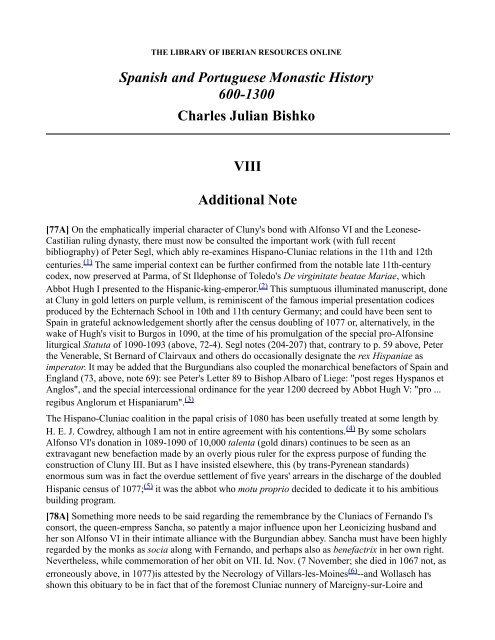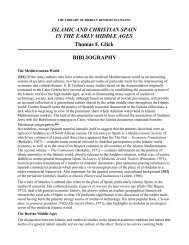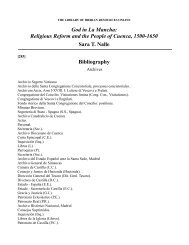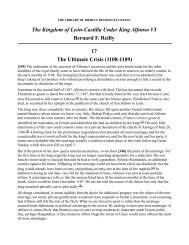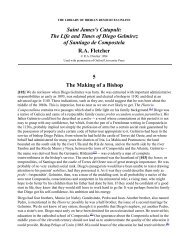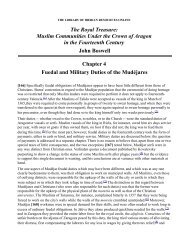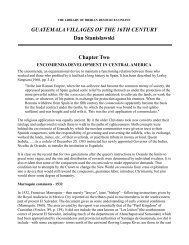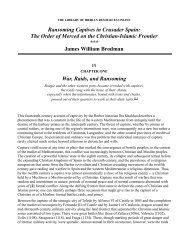Spanish and Portuguese Monastic History 600-1300 Charles Julian ...
Spanish and Portuguese Monastic History 600-1300 Charles Julian ...
Spanish and Portuguese Monastic History 600-1300 Charles Julian ...
Create successful ePaper yourself
Turn your PDF publications into a flip-book with our unique Google optimized e-Paper software.
THE LIBRARY OF IBERIAN RESOURCES ONLINE<br />
<strong>Spanish</strong> <strong>and</strong> <strong>Portuguese</strong> <strong>Monastic</strong> <strong>History</strong><br />
<strong>600</strong>-<strong>1300</strong><br />
<strong>Charles</strong> <strong>Julian</strong> Bishko<br />
VIII<br />
Additional Note<br />
[77A] On the emphatically imperial character of Cluny's bond with Alfonso VI <strong>and</strong> the Leonese-<br />
Castilian ruling dynasty, there must now be consulted the important work (with full recent<br />
bibliography) of Peter Segl, which ably re-examines Hispano-Cluniac relations in the 11th <strong>and</strong> 12th<br />
centuries. (1) The same imperial context can be further confirmed from the notable late 11th-century<br />
codex, now preserved at Parma, of St Ildephonse of Toledo's De virginitate beatae Mariae, which<br />
Abbot Hugh I presented to the Hispanic-king-emperor. (2) This sumptuous illuminated manuscript, done<br />
at Cluny in gold letters on purple vellum, is reminiscent of the famous imperial presentation codices<br />
produced by the Echternach School in 10th <strong>and</strong> 11th century Germany; <strong>and</strong> could have been sent to<br />
Spain in grateful acknowledgement shortly after the census doubling of 1077 or, alternatively, in the<br />
wake of Hugh's visit to Burgos in 1090, at the time of his promulgation of the special pro-Alfonsine<br />
liturgical Statuta of 1090-1093 (above, 72-4). Segl notes (204-207) that, contrary to p. 59 above, Peter<br />
the Venerable, St Bernard of Clairvaux <strong>and</strong> others do occasionally designate the rex Hispaniae as<br />
imperator. It may be added that the Burgundians also coupled the monarchical benefactors of Spain <strong>and</strong><br />
Engl<strong>and</strong> (73, above, note 69): see Peter's Letter 89 to Bishop Albaro of Liege: "post reges Hyspanos et<br />
Anglos", <strong>and</strong> the special intercessional ordinance for the year 1200 decreed by Abbot Hugh V: "pro ...<br />
regibus Anglorum et Hispaniarum". (3)<br />
The Hispano-Cluniac coalition in the papal crisis of 1080 has been usefully treated at some length by<br />
H. E. J. Cowdrey, although I am not in entire agreement with his contentions. (4) By some scholars<br />
Alfonso VI's donation in 1089-1090 of 10,000 talenta (gold dinars) continues to be seen as an<br />
extravagant new benefaction made by an overly pious ruler for the express purpose of funding the<br />
construction of Cluny III. But as I have insisted elsewhere, this (by trans-Pyrenean st<strong>and</strong>ards)<br />
enormous sum was in fact the overdue settlement of five years' arrears in the discharge of the doubled<br />
Hispanic census of 1077; (5) it was the abbot who motu proprio decided to dedicate it to his ambitious<br />
building program.<br />
[78A] Something more needs to be said regarding the remembrance by the Cluniacs of Fern<strong>and</strong>o I's<br />
consort, the queen-empress Sancha, so patently a major influence upon her Leonicizing husb<strong>and</strong> <strong>and</strong><br />
her son Alfonso VI in their intimate alliance with the Burgundian abbey. Sancha must have been highly<br />
regarded by the monks as socia along with Fern<strong>and</strong>o, <strong>and</strong> perhaps also as benefactrix in her own right.<br />
Nevertheless, while commemoration of her obit on VII. Id. Nov. (7 November; she died in 1067 not, as<br />
erroneously above, in 1077)is attested by the Necrology of Villars-les-Moines (6) --<strong>and</strong> Wollasch has<br />
shown this obituary to be in fact that of the foremost Cluniac nunnery of Marcigny-sur-Loire <strong>and</strong>
therefore closely based upon Cluny's own lost Necrology (7) --it remains true that at the time of her death<br />
in 1067 the queen-empress does not seem to have been allotted anything more than the customary<br />
annual commemoration of her anniversary. Only in later years, <strong>and</strong> thanks to the eleemosynary <strong>and</strong><br />
intercessional negotiations of her son Alfonso VI, can Doña Sancha be found enjoying also the<br />
exceptional privileges of inclusion alongside her husb<strong>and</strong> in the Fern<strong>and</strong>ine praebenda <strong>and</strong> the<br />
assignment of a special, if anonymous, collect.<br />
On several topics raised in the foregoing Study, some further brief observations may be made. The<br />
subject of intercessional commemoration linking the Cluniacs with lay rulers, nobles <strong>and</strong> other<br />
benefactors is being fruitfully pursued by Prof. Joachim Wollasch <strong>and</strong> his students. A recent byproduct<br />
is the quantitatively based monograph by Dietrich Poeck, which ably analyzes the donors, motives <strong>and</strong><br />
benefactorial concessions connected with the numerous lay burials made at Cluny in the 10th <strong>and</strong> 11th<br />
centuries. (8) On the major 11th-century Cluniac custumals or consuetudinaries of Bernard <strong>and</strong> Udalric,<br />
the badly needed <strong>and</strong> long awaited modern critical editions promised in the Corpus Consuetudinum<br />
<strong>Monastic</strong>arum directed by Dom Kassius Hallinger have yet to appear. Since neither Philippeau nor<br />
Hallinger in their valuable studies (published before my paper of 1961) on the codices <strong>and</strong><br />
chronological problematics of these works exploited the Hispanic intercessional passages assembled<br />
above, (9) the utility of my data in helping to narrow the respective dates of composition has yet to be<br />
assessed within the manuscript tradition as a whole. The statement (58, above) regarding noncelebration<br />
at Cluny of the nocturnal office during the Nativity octave should probably be restricted to<br />
mean only that pro defunctis.<br />
The view of the preceding Study that in the later 11th <strong>and</strong> early 12th centuries Cluny offered no such<br />
liturgical supplications for any other Iberian sovereigns as she did for the king-emperors of Leon,<br />
dem<strong>and</strong>s a certain degree of modification regarding the Navarro-Aragonese monarchs Pedro I (1094-<br />
1104) <strong>and</strong> Alfonso I el Batallador (1104-1134). Fifty years ago Ramackers published from the<br />
Collection Baluze in the Bibliothèque Nationale a text which Baluze himself had taken from fol. 74 v of<br />
Cluny's [79A] lost Obituary. This is a statutum or praeceptum of Abbot Hugh I which describes the<br />
admission to the abbey's societas of the French-born bishop Peter I of Pamplona (1083-1115), also<br />
known as Pierre d'Andouque, Pedro de Roda or Pedro de Anduque. (10) In addition to detailing various<br />
intercessional privileges accorded this celebrated prelate for his repeated generosities to the abbey, this<br />
piece also contains two highly interesting references to King Pedro I of Aragon-Navarre. In one<br />
passage, where the charities of Bishop Peter to the Burgundian congregation are warmly<br />
acknowledged, the text goes on to declare that not only did he journey all the way to Cluny "cum suis<br />
praeclaris muneribus" but that "secumque etiam munera domni Petri regis detulit." (11) A second such<br />
passage, after relating the Pamplonese bishop's admission to confraternity <strong>and</strong> the list of intercessional<br />
honors granted him in life, at the time of his death, <strong>and</strong> in commemoration of his anniversary, makes<br />
the following stipulation: "Hoc etiam disponimus, ut in omni uita sua oratio illa, quam pro salute domni<br />
Petri regis cotidie in missa dicendam stabiliuimus, pro ipso similiter dicatur, ut quae pro rege<br />
singulariter pronuntiaretur, nunc pluraliter pro ambobus proferatur." (12)<br />
These two extracts from the Cluniac Obituary provide firm evidence that at some point in his ten-year<br />
reign King Pedro I of Aragon-Navarre, ab<strong>and</strong>oning the coolness towards Cluny characteristic of both<br />
the Navarrese <strong>and</strong> Aragonese royal houses from ca. 1040 on, became a generous benefactor of the<br />
abbey <strong>and</strong> the recipient of exceptional liturgical intercession, through the inclusion, at Abbot Hugo's<br />
express order, of a special oratio on his behalf in the daily Mass. We can safely assume a substantial act<br />
of royal charity preceded this concession: one that took the form not of a census, as with Fern<strong>and</strong>o I<br />
<strong>and</strong> Alfonso VI, or Pedro's own current annual stipend to Rome, (13) but a donation of money or<br />
treasure, made at one specific time. When this occurred, under what circumstances, <strong>and</strong> with what
elevance for Cluny's previous imperial link with the reges Hispaniarum of Leon <strong>and</strong> Castile, are all<br />
questions calling for brief consideration.<br />
The chronology can be fixed with fair assurance. Since the Petrine oratio, once instituted, was still<br />
being observed at the time when Bishop Peter brought a second royal charity -- as well as his own<br />
munera, so praeclara as to induce the abbot to couple his name with that of his sovereign in the daily<br />
supplication -- it follows that we can distinguish two separate occasions of royal Aragonese-Navarrese<br />
benevolence. These in turn are most logically correlated with the two climactic points in Pedro I's reign<br />
when major victories over the infidel <strong>and</strong> acquisition of abundant spoils would prompt placing Cluny<br />
among the monasteries <strong>and</strong> churches with which the monarch piously shared his good fortune. The first<br />
of these would have been the reconquest of Huesca in 1096, <strong>and</strong> since this city with its rich booty did<br />
not capitulate until 27 November, (14) the royal munera are not likely to have reached Burgundy until<br />
the following spring or summer. Thus the year 1097 is most probably to be taken as the time when<br />
Hugo [80A] introduced a new daily collect in the Mass for the ruler of Pamplona <strong>and</strong> Jaca. Similarly,<br />
Pedro's I's second bestowal of munera, after what is clearly an interval of several years, can be linked<br />
to his capture of Barbastro in 1100. Once again, the date of the city's surrender falls in the autumn, on<br />
18 October, (15) so that Bishop Peter's crossing of the Pyrenees <strong>and</strong> appearance at Cluny with his<br />
monarch's new benefaction are most naturally placed in the summer of 1101.<br />
If we can thus perceive that from 1097 on, during Alfonso VI's later years, a reciprocal bond of<br />
benefaction <strong>and</strong> liturgical recognition for the first time united Cluny with the king-emperor's principal<br />
opponent in Christian Spain, the resolutely anti-imperial monarch of the Aragonese-Navarrese<br />
federation, are we to interpret this as the extension of the bitter political enmities of the Peninsula into<br />
the very choir of the Burgundian abbey-church (16)<br />
Three things seem reasonably plain. First, the two royal Petrine donations, of presumably 1097 <strong>and</strong><br />
1101, must reflect in part at least the persuasive influence upon Pedro I of the bishop of his Navarrese<br />
capital. The latter's ties with the Cluniacs, although secondary to those with his old alma mater Sainte-<br />
Foi de Conques, possibly go back to soon after his installation in 1084, under Sancho Ramirez, as head<br />
of the Church of Pamplona. (17) He was present with the king at the fall of both Huesca <strong>and</strong> Barbastro,<br />
when spoils were being distributed to religious centers on both sides of the Pyrenees; (18) <strong>and</strong>, in the<br />
case of Sainte-Foi de Conques at least, we have direct testimony to his ability to induce both Sancho<br />
Ramirez <strong>and</strong> Pedro I, as well as their nobles, to bestow alms upon foreign monks. (19) Secondly, the<br />
collect pro salute domni Petri regis st<strong>and</strong>s as a vitalicial, purely personal supplication, with no<br />
provision for dynastic continuation. Thirdly, although impressively honorific, the Petrine oratio fails to<br />
place the Aragonese-Navarrese sovereign on anything like the exalted plane of the imperial Hispanic<br />
intercessional privileges, as these are recorded in the custumals of Bernard <strong>and</strong> Udalric <strong>and</strong> in the<br />
Hugonic Statuta; <strong>and</strong> the fact that Bishop Peter's praeclara munera could equate him with his king in<br />
the oratio confirms the distinctly secondary level of liturgical solemnity allowed the king of Jaca <strong>and</strong><br />
Pamplona.<br />
Other implications are less readily determinable, <strong>and</strong> merit further inquiry. A highly probable factor in<br />
bringing about the novel friendship of Cluny with Pedro I may have been the increasingly strained<br />
relations between Abbot Hugh <strong>and</strong> Alfonso VI in the latter's last two decades, although the Aragonese-<br />
Navarrese benefactions of 1097 <strong>and</strong> 1101 both precede by some years the apparent disruption of<br />
Alfonsine-Cluniac amity. This estrangement intensifies, probably, in 1103, when the king-emperor first<br />
begins publicly to acknowledge his half-Moorish son, the Infante Sancho, as his heir designate, <strong>and</strong><br />
culminates in 1105, when Cluny's mediation of the [81A] successoral pact between the Burgundian<br />
counts Raimundo of Galicia <strong>and</strong> Henrique of Portugal demonstrates her defiance of Alfonso <strong>and</strong><br />
determined adhesion to the original plan, the co-succession of Raimundo <strong>and</strong> Doña Urraca. (20) Yet,
even before 1103-1105 or Pedro's first donation of 1097, we can suspect a marked cooling of Abbot<br />
Hugh's affection for the Leonese-Castilian emperor caused by an undocumentable but strongly<br />
indicated suspension of the Hispanic census by reason of Alfonso's loss of his Taifa tributaries <strong>and</strong> the<br />
financial dem<strong>and</strong>s of the Almoravid war.<br />
Thus it becomes possible to conjecture that in Aragon-Navarre in 1097, following the lucrative<br />
conquest of Huesca, it was not only royal piety but also conscious foreign policy that motivated the<br />
sending of Muslim booty from the fallen city to Cluny in a calculated effort to exploit the abbey's<br />
strained ties with Leon <strong>and</strong> attract Hugo's influential support towards Jaca-Pamplona. And are we<br />
similarly justified in deducing that the Cluniac abbot, desperate for funds to maintain his costly<br />
building program, to say nothing of the burden of feeding <strong>and</strong> clothing his large congregation, cordially<br />
welcomed this Iberian charity from an unexpected source, the long hostile Aragonese-Navarrese royal<br />
house, <strong>and</strong>, even at the risk of displeasing the Leonese-Castilian rex-imperator, gratefully elevated<br />
King Pedro I to the limited ranks of those exalted persons who, along with the reges Hispaniarum,<br />
received daily mention in the formal supplications of his famed center of liturgical intercession There<br />
is reason to think that to both of these questions affirmative answers are in order; but pending further<br />
archival investigation <strong>and</strong> much closer study of Hispano-Cluniac affairs in Alfonso VI's two terminal<br />
decades, the case must obviously be left sub judice.<br />
On the other h<strong>and</strong>, Pedro's successor in 1104, Alfonso I, may for some few years between 1109 <strong>and</strong><br />
1113 have received full imperial intercessional privileges as the consort of the queen-empress Urraca, if<br />
not in consequence of the latter's accession to the Leonese-Castilian throne in July 1109, then during<br />
<strong>and</strong> after the years of bitter hostility between the two spouses when el Batallador claimed <strong>and</strong> used the<br />
Hispanic imperial title in his own right. Alfonso reputedly made gifts to Cluny <strong>and</strong> may have briefly<br />
enjoyed the abbey's recognition; obscurity surrounds this never seriously investigated question; (21) but<br />
any friendship between the Burgundian monks <strong>and</strong> this formidable reconquistador who regarded<br />
himself as the legitimate ruler of both Navarre-Aragon <strong>and</strong> Leon-Castile must have terminated by 1113.<br />
This was the year -- as I have contended ("The <strong>Spanish</strong> Journey of Abbot Ponce," Study X in this<br />
volume) -- of the intervention in the <strong>Spanish</strong> dynastic crisis of the Cluniac head, Ponce de Melgueil,<br />
<strong>and</strong> the abbey's henceforth open alignment with the anti-Aragonese cause of Doña Urraca <strong>and</strong> her<br />
young son Alfonso Raimúndez, the future Alfonso VII.<br />
One possible by-product of these royal Aragonese contacts with the abbey under Pedro I <strong>and</strong> Alfonso I<br />
has never been given the attention it surely merits. This is the gift to the Cluniacs, made first in 1133,<br />
<strong>and</strong> again in 1141 <strong>and</strong> 1145, by the Aragonese [82A] magnate Fortún Garcés Cajal of what became the<br />
one Burgundian priory in Navarre, San Adrián de Vadoluengo near Sangüesa; see "Peter the Venerable's<br />
Traverse" (Study XIII in this volume), from around note 44 of text. Cajal, long governor of Nájera <strong>and</strong><br />
other Alfonsine tenencias in the Rioja, is the one Aragonese baron known to have endowed Cluny; his<br />
generosities may well be connected with those of the two kings, with whom he claimed a blood<br />
relationship.
Notes for Study Eight: Additional Note<br />
1. Peter Segl, Königtum und Klosterreform in Spanien (Kallmünz, 1974), 193-217.<br />
2. M. Schapiro, The Parma Ildefonsus: A Romanesque Illuminated Manuscript from Cluny <strong>and</strong> Related<br />
Works (n.p. 1964); but this study errs on the historical context of the gift. Cf. also C. R. Dodwell, "The<br />
Gospel-Book of Goslar," Times Literary Supplement, 19 Nov. 1976, 1463-4.<br />
3. The Letters of Peter the Venerable, ed. Giles Constable (Cambridge, Mass., 1967), I, 229 (Ep. 89); II,<br />
157-9; PL CLXXXIX, 279A (Ep. Ill, 2); Statuts, chapîtres généraux et visites de l'Ordre de Cluny, ed.<br />
G. Charvin (Paris, 1965- ), I, 52.<br />
4. H. E. J. Cowdrey, The Cluniacs <strong>and</strong> the Gregorian Reform (Oxford, 1970), 214-47.<br />
5. See my "Fern<strong>and</strong>o I <strong>and</strong> the Origins of the Leonese-Castilian Alliance with Cluny" in Studies in<br />
Medieval <strong>Spanish</strong> Frontier <strong>History</strong> (London, 1980), 46 50; <strong>Spanish</strong> version in Cuadernos de historia<br />
de España, XLVII-XLVIII (1968), 122-7.<br />
6. Necrologium des Cluniacenser-Priorates Münchenwiler (Villars-les-Moines), ed. Gustav Schnürer<br />
(Freiburg, Schweiz, 1909. Collectanea Friburgensia, N. F., X). Under VII. ID. Nov. appear the words<br />
Sanctia Regina (p. 83); the Longpont necrology reads Sanctia regina Hyspanorum (ibid.).<br />
7. Joachim Wollasch, "Qu'a signifié Cluny pour l'abbaye de Moissac" in Moissac et l'Occident au XIe<br />
siècle (Toulouse, 1964), 13-24 (also, Annales du Midi, LXXV, 1963, 345-52); idem, "Ein<br />
cluniacensisches Totenbuch aus der Zeit Abt Hugos von Cluny," Frühmittelallerliche Studien, I (1967),<br />
406-43.<br />
8. D. Poeck, "Laienbegräbnisse in Cluny," Frühmittelalterliche Studien, XV (1981), 68-179.<br />
9. H. R. Philippeau, "Pour l'histoire de la coutume de Cluny," Rev. Mabillon, XLIV (1954); 141-51; K.<br />
Hallinger, "Klunys Bräuche zur Zeit Hugos des Grossens (1049-1109)," Zeitschrift der Savigny-<br />
Stiftung für Rechtsgeschichte, Kanonist. Abteil., XLV (1959), 99-140. On the unexplored Iberian<br />
circulation of Bernard's custumal, <strong>and</strong> a hypothesis of its passage via Sahagun to Sao Vicente de<br />
Pombeiro <strong>and</strong> other <strong>Portuguese</strong> houses, see J. Mattoso, Le monachisme ibérique et Cluny (Louvain,<br />
1968), 125, 204, 216, 223, 272-4, 375-7.<br />
10. Johannes Ramackers, "Analekten zur Geschichte des Rcformpapsttums und der Cluniacenser,"<br />
Quellen und Forschungcn aus italienischen Archiven und Bibliotheken, XXIII (1931 -32), 48-9 (no.<br />
XVIII); cf. 30-2. See also H. E. J. Cowdrey, "Unions <strong>and</strong> Confraternity with Cluny," Journ. Econ. Hist.,<br />
XVI (1965), 161, to which I owe this reference. On Peter, see J. Goñi Gaztambide, "Los obispos de<br />
Pamplona del siglo XII," Anthologica Annua, XIII (1965), 147-95.<br />
11. Ramackers, 48.<br />
12. Ibid., 49.<br />
13. P. Kehr, "El papado y los reinos de Navarra y Aragón hasta mediados del siglo XII," in Estudios de<br />
Edad Media de la Corona de Aragón, II (1946), 130 3; Ant. Ubieto Arteta, Colección diplomática de<br />
Pedro I de Aragón y Navarra (Zaragoza, 1951), 159 60.<br />
14. Ant. Ubieto Arteta, Historia de Aragón. [I] La formación territorial (Zaragoza, 1981), 122-8.<br />
15. Ibid., 129-30.<br />
16. On Aragonese-Navarrese relations with Castile under Sancho Ramirez <strong>and</strong> Pedro I, see Ant. Ubieto<br />
Arteta, "Homenaje de Aragón a Castilla por el condado de Navarra," EEMCA, III (1947-48), 7-28;<br />
idem, Col. dipt, de Pedro I, 129-31.
17. Cf. Abbot Hugh's words "in episcopatu suo nobis... magna et multa exhibuisset karitatis seruitia"<br />
(Ramackers, 48).<br />
18. Ubieto Arteta, Col. dipl, de Pedro I, 96-7 <strong>and</strong> Docs. nos. 24, 25 (Huesca), 96 (Barbastro).<br />
19. See the prose prologue to the versified biography of Peter preserved in t. 143 of the Collection<br />
Doat, Bibl. Nat., Paris: "Procurauit etiam multa bona conferri dicto Conchensi monesterio... a felicis<br />
memoriae Sancio et Petro Sancii filio ipsius regibus pampilonae et aragonum" (fol. 177v).The same<br />
prologue cites Bishop Peter's establishment of a permanent confraternal sociale foedus between the<br />
fratres Conchenses <strong>and</strong> the cathedral chapter of Pamplona (fols. 177-177V); this must have antedated<br />
his personal entry into societas with Cluny.<br />
20. P. David, "Le pacte succesoral entre Raymond de Galice et Henri de Portugal," Bull, hisp., L<br />
(1948), 275-90, at 285-8. On the date 1105, <strong>and</strong> the historical circumstances of the intervention of the<br />
Cluniac chamberlain Dalmace Geret in the imperial succession crisis, see my "Count Henrique of<br />
Portugal" (Study IX in this volume).<br />
21. Some suggestive data on Alfonso I's imperial status down to 1126 (Urraca's death) or 1127 (Peace<br />
of Támara) can be found in J. M. Ramos y Loscertales, "La sucesión del rey Alfonso VI," An. hist.<br />
derecho esp., XIII (1936-41), 36-99 (at 62ff.); J. M. Lacarra, Alfonso el Batallador (Zaragoza, 1978),<br />
62 <strong>and</strong> note 14; Bernard F. Reilly, The Kingdom of León-Castilla under Queen Urraca, 1109-1126<br />
(Princeton, 1982), 106-7, 121, 170-1, 180, 194; but none of these works considers the bearing on the<br />
Leonese-Cluniac alliance.


